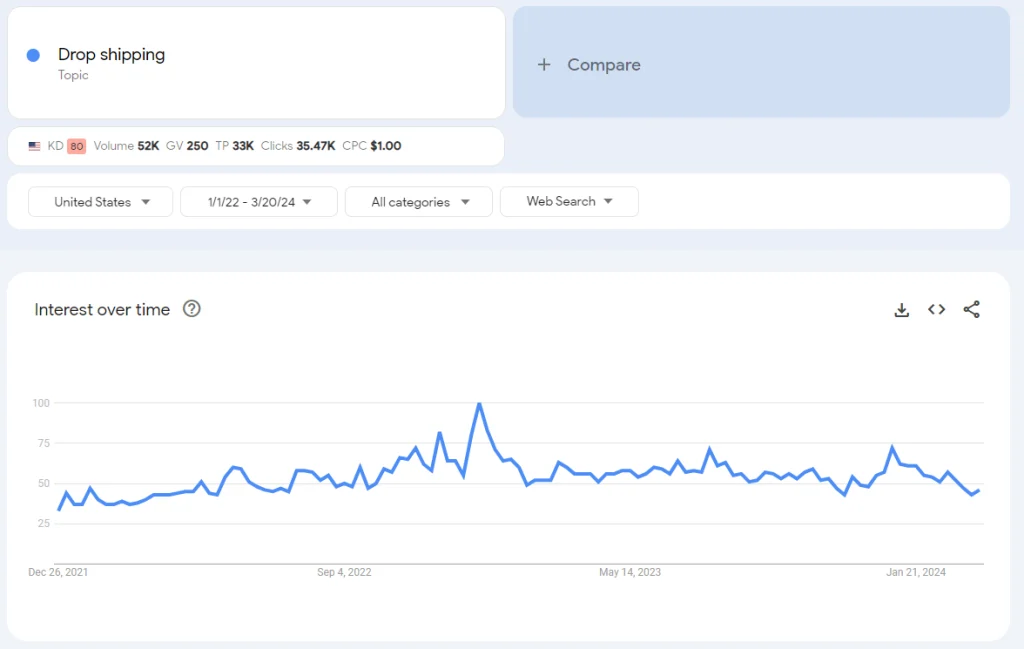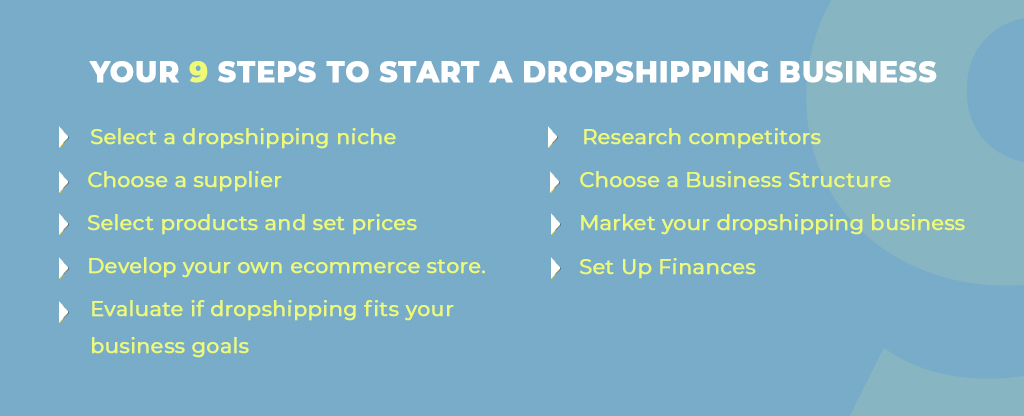How To Start A Dropshipping Business In Just 9-Steps
11 Sep 24 


Ever wondered about the size of the dropshipping world? It’s huge! Worth over $225 billion and growing fast yearly. Allied Market Research thinks it’ll hit $1.67 trillion by 2031.
Starting a dropshipping business is a profitable business, but it’s smart to know the common hurdles first. This blog will help you make better choices. Let’s dive in.
What is dropshipping ?
When a customer places an order, the order details are sent to a supplier. The supplier then ships the item directly to the customer.
Many retailers choose dropshipping because it shifts order fulfillment to suppliers. This means stores don’t need warehouses or risk having unsold stock. As a result, businesses can focus more on other areas like marketing.
Dropshipping is a significant part of ecommerce, with yearly sales estimated at over $300 billion.
Also Read: How Much is the Average Cost of Ecommerce App Development?
Is dropshipping worth it in 2024?
To assess the profitability of drop shipping, let’s examine the trend over time.

The graph above shows a significant increase in searches for “dropshipping” from 2021 to 2022. While the trend decreased sharply in early 2023, it has since stabilized. This suggests that the ecommerce dropshipping market has largely saturated but is now reaching a stable point.
How popular is dropshipping in 2024? Research indicates that global dropshipping reached $276.71 billion in 2023 and is expected to grow at a 23.20% CAGR by 2032. Notably, over 30% of online stores use drop shipping for order fulfillment, and dropshippers account for about 34% of Amazon drop shipping sales.
Considering these factors, dropshipping remains profitable and offers opportunities. This may answer the question “Is dropshipping worth it?” for some. However, success in this competitive market requires vigilance, adaptability, and customer focus. Before starting a dropshipping business, it’s essential to conduct thorough market research, stay informed about industry trends, and carefully evaluate your chosen niche’s potential.
Your 9 steps to start a dropshipping business

1. Evaluate if dropshipping fits your business goals
Dropshipping is one option for running an online store. Before starting, make sure it aligns with your objectives.
This model often suits people with marketing skills who want to start a store with low initial costs. Since you don’t need to keep inventory or handle products, you can begin with just a computer and internet access.
However, this ease of entry has drawbacks. Dropshippers typically have less control over their product range, and because other sellers often offer the same items, competition can be fierce.
If you intend to focus on marketing and aren’t aiming to build your business around a specific product, then dropshipping might be a good fit.
2. Select a dropshipping niche
A niche is a specific market segment. Your store, brand, and products can target a particular niche.
Picking a dropshipping niche helps you identify your target customers. With a clear audience in mind, it’s simpler to find suitable products to sell.
There are two main approaches to choosing a business niche:
- Select a niche you know well or are passionate about.
- Choose a niche based on market demand.
The second method aims to find niches with high customer interest but low competition. Dropshippers evaluate market demand through keyword and product research.
- Finding a niche with keyword research
Keyword research reveals popular online searches. Tools like Google Trends and Facebook Audience Insights show product-related queries your store could target. When evaluating demand, consider both historical interest and search volume to find niches with steady or growing popularity.
- Finding a niche with product research
Product research helps identify trending items and consumer preferences. Dropshipping apps like DSers display order volumes on marketplaces, indicating potential business size.
Use both research types to understand a dropshipping niche fully. Consumer trends change quickly, so regularly check keyword and product popularity.
You may also choose your supplier before selecting a niche to ensure product availability.
3. Research competitors
Competitor analysis is crucial when starting a dropshipping business. Invest time in gathering data about other stores in your niche.
By studying your competitors, especially fellow dropshippers, you can spot potential products and marketing tactics. Examine product pages and social media ads to understand what customers like.
Perform thorough competitor research with these steps:
- Search on Google
- Use competitor analysis tools
- Search through social media
- Explore marketplaces
4. Choose a supplier
A dropshipping supplier handles inventory, processes orders and payments, and ships products to customers. Your choice of supplier greatly affects your dropshipping business’s success due to these key responsibilities.
Based on your niche and products, you may work with one supplier or multiple suppliers through a directory. Popular apps and websites for supplier directories automatically link your store to many dropshipping suppliers.
For instance, the DSers app allows Shopify users to dropship items from AliExpress, a global marketplace.
5. Select products and set prices
Choose products that fit your niche audience from your supplier’s inventory. A well-curated catalog can boost cross-selling and upselling opportunities.
When selecting products:
- Check seller reviews and supplier history
- Order samples to verify quality
- Consider items with fast shipping options
- Pricing your dropshipping products
Develop a pricing strategy that ensures profitability:
- Calculate costs, including supplier price and operating expenses
- Set a profit margin for each product
- Compare prices with market competitors
A balanced approach to product selection and pricing is crucial for a sustainable dropshipping business. Focus on quality, shipping speed, and competitive pricing to stand out in the market.
6. Develop your own ecommerce store.
Your online store is the core of your dropshipping business. It displays your products and allows customers to make purchases. It’s also where people land after clicking your social media ads.
Besides product pages, your store can include content to improve customer experience. This includes customer reviews, how-to guides, product comparisons, and relevant articles. Extra content helps customers decide and can boost your store’s visibility in search results.
Shopify’s store builder offers a highly effective checkout process and flexible design options. You can customize your store’s look with professional themes that match your brand.
Adding a dropshipping app to your online store makes managing products and processing orders easier.
7. Choose a Business Structure
When starting a dropshipping business, it’s important to select an appropriate legal structure. Three common options are:
- Sole proprietorship: Sole Proprietorship is the simplest structure, run by one person with minimal paperwork. It’s cost-effective but offers no personal asset protection.
- Limited liability company (LLC): LLC separates personal and business finances, providing better protection. It offers tax benefits but requires more paperwork and fees than a sole proprietorship.
- C corporation: Large businesses often use C corporation for extensive liability protection. It’s expensive to set up and involves double taxation.
Most US businesses need an Employer Identification Number (EIN) for taxes, wholesale accounts, and banking. Apply for one when setting up your business.
8. Set Up Finances
Organizing your finances is crucial for ensuring smooth operations in your business:
- Open a Business Bank Account: It is important to keep your business and personal finances separate. This helps in tracking expenses and income accurately, making tax time easier.
- Accounting Software: Utilize reliable business accounting software for effective bookkeeping. These programs can help you manage invoices, track expenses, and generate financial reports, which are essential for making informed decisions
- Payment Gateways: Establish secure payment options like Shopify Payments, PayPal, and Stripe. These gateways provide safe transactions for your customers and help you manage payments efficiently, enhancing the overall customer experience.
9. Market your dropshipping business
After launching your store, focus on marketing to drive traffic and boost success. Develop strategies for these key channels:
- Paid ads: Test ads on social media and Google to increase brand awareness and target potential customers.
- Influencer marketing: Partner with influencers to expand reach and build credibility. Use Shopify Collabs to find and pay influencers.
- Content marketing: Create valuable content like blogs, videos, or podcasts to engage customers.
- Communities: Participate in online groups related to your niche to build relationships.
- Mobile marketing: Use SMS marketing for high engagement. Offer VIP chats, support, and promo codes.
- Email marketing: Send personalized emails with promotions and useful information to encourage repeat business.
Experiment with these strategies to find the most effective approach for your dropshipping business.
Launch your ecommerce store in 2024
Starting an ecommerce business is now more easy than ever. Whether you’re a side hustler, an entrepreneur, or aiming to grow your existing store, ecommerce app development makes online selling efficient and cost-effective.
Begin your journey today and integrate popular dropshipping apps or sell products from established brands. Mindster, a leading e-commerce app development company, can help you create a robust platform tailored to your needs.
- Android Development3
- Artificial Intelligence25
- Classified App3
- Custom App Development2
- Digital Transformation11
- Doctor Appointment Booking App13
- Dropshipping1
- Ecommerce Apps38
- Education Apps2
- Fintech-Apps34
- Fitness App2
- Flutter3
- Flutter Apps19
- Food Delivery App5
- Grocery App Development1
- Grocery Apps3
- Health Care7
- IoT2
- Loyalty Programs9
- Matrimony Apps1
- Microsoft1
- Mobile App Maintenance2
- Mobile Apps120
- Product Engineering4
- Progressive Web Apps1
- Saas Application2
- Shopify7
- Software Development1
- Taxi Booking Apps7
- Truck Booking App5
- UI UX Design8
- Uncategorized4
- Web App Development1



















Comments